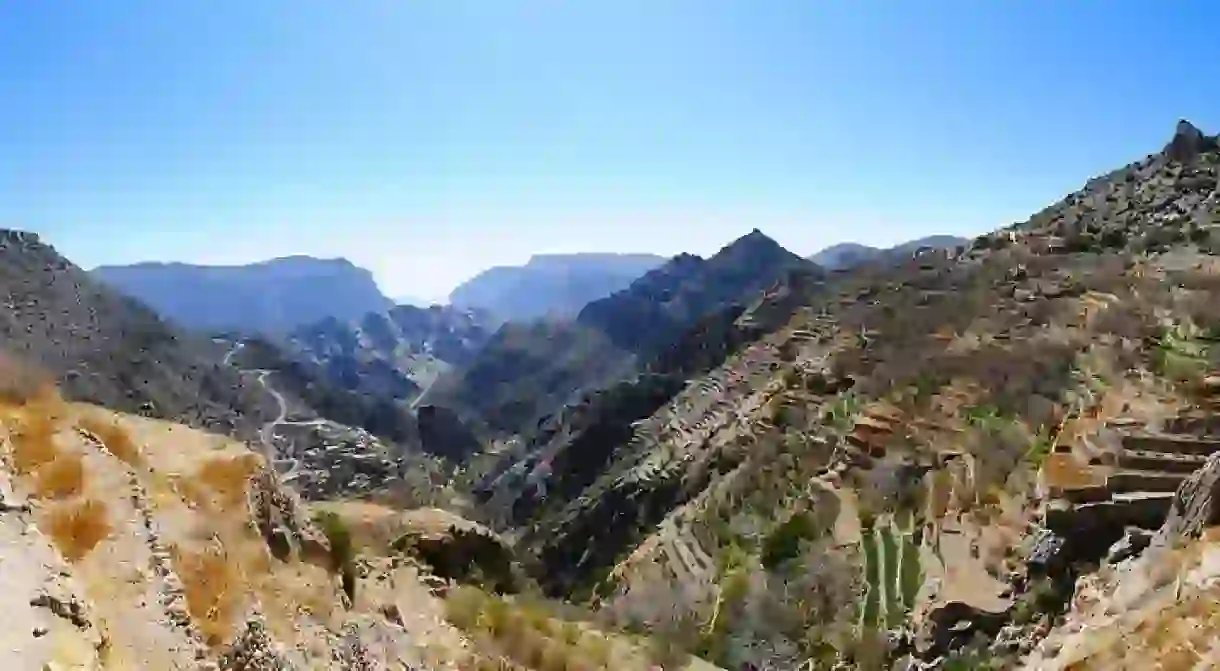Why You Shouldn't Miss Oman’s Ad Dakhiliyah Province

Oman’s interior has been recognised as one of the Arabian Peninsula’s cradles of civilisation, home to countless leaders, kings, and architects who transformed this corner of the region. Renowned for its brilliant forts, scenic ruins, and evergreen oases, no trip to the Sultanate is a complete without a journey here. The reason why is simple: a trip to the interior is one to the very heart of the culture, history, and traditions that gave us Oman as we know it today.
Jebel Akhdar
The majestic Jebel Akhdar is part of the Al Hajar Mountain chain and has attracted ardent travellers for years. Highly popular thanks to its resorts and cool climate, Jebel Akhdar is also home to farms built on elevated terraces, hiking trails that run through ruins, and rosewater farms.
Jebel Akhdar was also the main battleground of the Jebel War, which lasted from 1954-1959. During the conflict, supporters of Oman’s last imamate opposed the authority of the Sultan of Muscat from atop the mountain. The remnants of the war are scattered across the mountain in the form of plane wreckage that is still visible today.

Birkat Al Mowz
Situated at the foot of Jebel Akhdar, the evergreen oasis village of Birkat Al Mowz has served as a gateway to Oman‘s most famous mountain for centuries. The village is filled with dozens of old homes and ruins, all surrounded by picturesque banana and date farms.
Birkat Al Mowz’s prosperity has been closely tied to that of the mountain, and travellers can get a first-hand look at the connection by checking out the village’s Falaj Al Khatmayn – a water channel cut hundreds of years ago to provide the village with water directly from Jebel Akhdar. The water channel is fed by Wadi Muaydin – one of the largest of its kind in Oman. It boasts water all year round despite desert conditions, and has played a pivotal role in the agricultural growth of the village since its inception.
Following the channel will instantly take visitors through the old town and straight toward the village’s iconic Bayt Al Rudaydah Fort. Another centuries-old stronghold, Bayt Al Rudaydah is not only scenic, but it also houses a weapons museum that is a perfect detour before heading into the mountain itself. Those with a little more time can explore the nearby Masjid Imam, which is said to have been built in the 17th century.
Nizwa
Once the home of Oman’s imamate, the city of Nizwa has had a longstanding role in the history of the Sultanate that can still be seen in its ancient forts, souks, and mosques. Chief among them is the iconic Nizwa Fort, which was originally built in the 9th century. Its massive 17th-century guntower is estimated to be 36 meters (118 feet) in diameter, with ports where 23 guns can cover all directions. Other must-see sites include two of Oman’s oldest mosques: Masjid Shawadhina, officially built in 628 AD and rebuilt in 1529. and the Great Mosque of Sa’al. Both feature unique and richly decorated mihrabs
Travellers will find Nizwa a convenient base for trips to some of the Sultanate other major sites, with the former capital situated in close proximity to Jebel Shams, Jebel Akhdar, Bahla, and Manah. The city is also a good starting point for explorers looking to go beyond the interior and venture toward Ibri, the UNESCO-protected ‘beehive’ tombs, and Wadi Nakhr, Oman’s very own ‘grand canyon’. However, those who make the trip will find Nizwa alone to be more than worth journey, with more than enough historic sites and natural wonders to keep them busy for days on end.

Bahla
Home to the largest fort in the Sultanate, the oasis town of Bahla has long been seen as the second cultural capital of Oman, as it was once the seat of the mysterious Nabhani dynasty of kings that ruled from 1154-1624. Like Nizwa, Bahla’s ancient past helped shaped Oman’s present, with it being the site of numerous battles between competing local dynasties and the Abbasid Caliphate for control of Oman. Visitors will quickly gain an appreciation for the area’s history by exploring the ancient villages, fortifications, and mosques of Bahla.
No trip would be complete with a stop at the Bahla Fort and its five impressive towers. The massive structure is truly an Arabian wonder, with some experts dating its earliest fortifications to the pre-Islamic period. Not far lies the Great Mosque of Bahla, which a UNESCO World Heritage Site. The richly decorated mihrab, a stunning example of tradition Omani craftsmanship, is widely held as a architectural wonder and was completed in the year 1511.
Jebel Shams
There is no place in the region quit like Jebel Shams, one of Oman’s largest natural wonders. Perfect for camping or hiking trips away from the hustle and bustle of modern life, Jebel Shams rises to an altitude of 3,004 meters (9,856 feet) above sea level, making it the highest peak in the Arabian Peninsula. Visitors to Jebel Shams will find a world of slopes, terraces, and summits waiting to be explored, as well as the Nakhr Balcony near the peak, where travellers can witness its gorgeous ravine. The climate at Jebel Shams is relatively mild during Oman’s summers and cold during wintertime, giving it an allure that attracts visitors – both tourists and adventurers – all year round.













